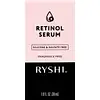What's inside
What's inside
 Key Ingredients
Key Ingredients

 Benefits
Benefits

 Concerns
Concerns

No concerns
 Ingredients Side-by-side
Ingredients Side-by-side

Water
Skin ConditioningPropanediol
SolventPhenoxyethanol
PreservativeCaprylyl Glycol
EmollientGlycerin
HumectantGlyceryl Acrylate/Acrylic Acid Copolymer
HumectantPvm/Ma Copolymer
Emulsion StabilisingSodium Hydroxide
BufferingPolysorbate 20
EmulsifyingHydroxyethylcellulose
Emulsion StabilisingDisodium Phosphate
BufferingSodium Phosphate
BufferingPolysorbate 60
EmulsifyingPanthenol
Skin ConditioningRetinol
Skin ConditioningCaprylic/Capric Triglyceride
MaskingBHT
AntioxidantWater
Skin ConditioningAzelaic Acid
BufferingButylene Glycol
HumectantAloe Barbadensis Leaf Juice
Skin ConditioningPropanediol
SolventCaprylic/Capric Triglyceride
MaskingKojic Acid
AntioxidantPolysorbate 20
EmulsifyingGlycerin
HumectantCaprylyl Glycol
EmollientHexylresorcinol
AntimicrobialEthyl Linoleate
EmollientLeuconostoc/Radish Root Ferment Filtrate
AntimicrobialDodecane
PerfumingHydroxyethylcellulose
Emulsion StabilisingXanthan Gum
EmulsifyingHelianthus Annuus Seed Oil
EmollientSqualane
EmollientBisabolol
MaskingGlyceryl Laurate
EmollientGlyceryl Undecylenate
EmollientAllantoin
Skin ConditioningRibose
HumectantSodium Acetate
BufferingBakuchiol
AntimicrobialGlycyrrhiza Glabra Root Extract
BleachingCellulose
AbsorbentPhenoxyethanol
PreservativeWater, Azelaic Acid, Butylene Glycol, Aloe Barbadensis Leaf Juice, Propanediol, Caprylic/Capric Triglyceride, Kojic Acid, Polysorbate 20, Glycerin, Caprylyl Glycol, Hexylresorcinol, Ethyl Linoleate, Leuconostoc/Radish Root Ferment Filtrate, Dodecane, Hydroxyethylcellulose, Xanthan Gum, Helianthus Annuus Seed Oil, Squalane, Bisabolol, Glyceryl Laurate, Glyceryl Undecylenate, Allantoin, Ribose, Sodium Acetate, Bakuchiol, Glycyrrhiza Glabra Root Extract, Cellulose, Phenoxyethanol
 Reviews
Reviews

Ingredients Explained
These ingredients are found in both products.
Ingredients higher up in an ingredient list are typically present in a larger amount.
This ingredient is an emollient, solvent, and texture enhancer. It is considered a skin-softener by helping the skin prevent moisture loss.
It helps thicken a product's formula and makes it easier to spread by dissolving clumping compounds.
Caprylic Triglyceride is made by combining glycerin with coconut oil, forming a clear liquid.
While there is an assumption Caprylic Triglyceride can clog pores due to it being derived from coconut oil, there is no research supporting this.
Learn more about Caprylic/Capric TriglycerideCaprylyl Glycol is a humectant and emollient, meaning it attracts and preserves moisture.
It is a common ingredient in many products, especially those designed to hydrate skin. The primary benefits are retaining moisture, skin softening, and promoting a healthy skin barrier.
Though Caprylyl Glycol is an alcohol derived from fatty acids, it is not the kind that can dry out skin.
This ingredient is also used as a preservative to extend the life of products. It has slight antimicrobial properties.
Learn more about Caprylyl GlycolGlycerin is already naturally found in your skin. It helps moisturize and protect your skin.
A study from 2016 found glycerin to be more effective as a humectant than AHAs and hyaluronic acid.
As a humectant, it helps the skin stay hydrated by pulling moisture to your skin. The low molecular weight of glycerin allows it to pull moisture into the deeper layers of your skin.
Hydrated skin improves your skin barrier; Your skin barrier helps protect against irritants and bacteria.
Glycerin has also been found to have antimicrobial and antiviral properties. Due to these properties, glycerin is often used in wound and burn treatments.
In cosmetics, glycerin is usually derived from plants such as soybean or palm. However, it can also be sourced from animals, such as tallow or animal fat.
This ingredient is organic, colorless, odorless, and non-toxic.
Glycerin is the name for this ingredient in American English. British English uses Glycerol/Glycerine.
Learn more about GlycerinHydroxyethylcellulose is used to improve the texture of products. It is created from a chemical reaction involving ethylene oxide and alkali-cellulose. Cellulose is a sugar found in plant cell walls and help give plants structure.
This ingredient helps stabilize products by preventing ingredients from separating. It can also help thicken the texture of a product.
This ingredient can also be found in pill medicines to help our bodies digest other ingredients.
Learn more about HydroxyethylcellulosePhenoxyethanol is a preservative that has germicide, antimicrobial, and aromatic properties. Studies show that phenoxyethanol can prevent microbial growth. By itself, it has a scent that is similar to that of a rose.
It's often used in formulations along with Caprylyl Glycol to preserve the shelf life of products.
Polysorbate 20 is made by combining ethoxylation of sorbitan, ethylene oxide, and lauric acid. It is a mild cleansing agent, surfactant, and emulsifier.
As a surfactant, it helps collect dirt and oils for washing. Emulsifiers prevent oils and water from separating.
Polysorbate 20 also adds scent to a product. Since it is made using sorbitol, it has a sweet scent. Sorbitol can also be found in fruits such as apples and peaches.
The lauric acid used to create Polysorbate 20 is often derived from coconuts.
Polysorbate 20 may not be fungal acne safe.
Learn more about Polysorbate 20Propanediol is an all-star ingredient. It softens, hydrates, and smooths the skin.
It’s often used to:
Propanediol is not likely to cause sensitivity and considered safe to use. It is derived from corn or petroleum with a clear color and no scent.
Learn more about PropanediolWater. It's the most common cosmetic ingredient of all. You'll usually see it at the top of ingredient lists, meaning that it makes up the largest part of the product.
So why is it so popular? Water most often acts as a solvent - this means that it helps dissolve other ingredients into the formulation.
You'll also recognize water as that liquid we all need to stay alive. If you see this, drink a glass of water. Stay hydrated!
Learn more about Water